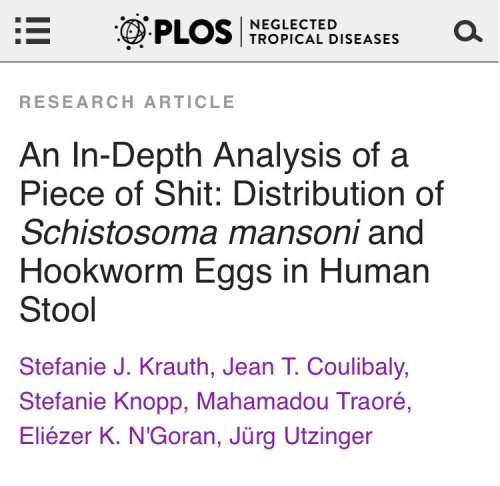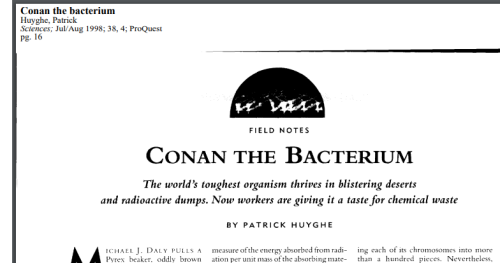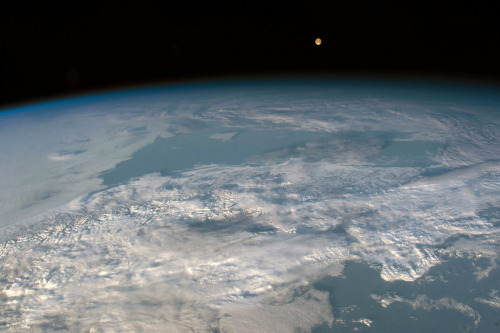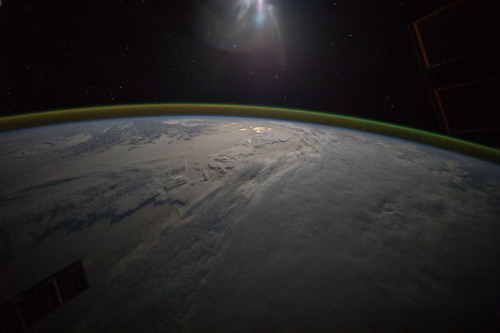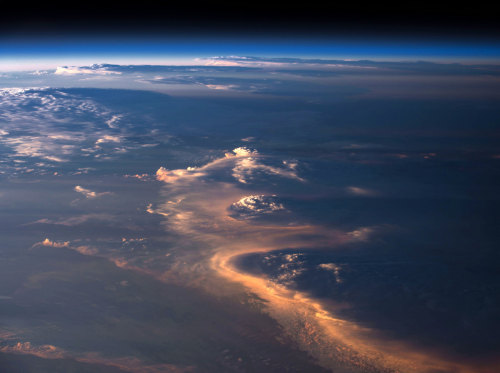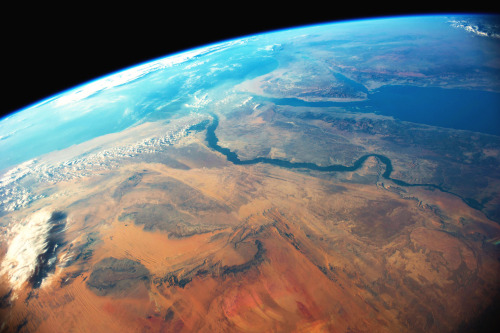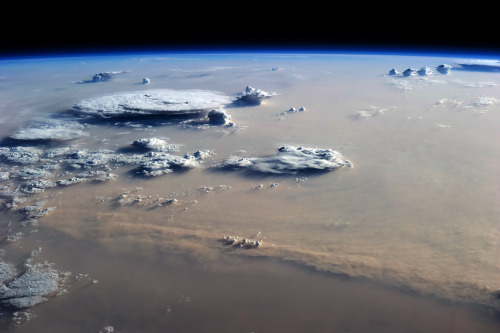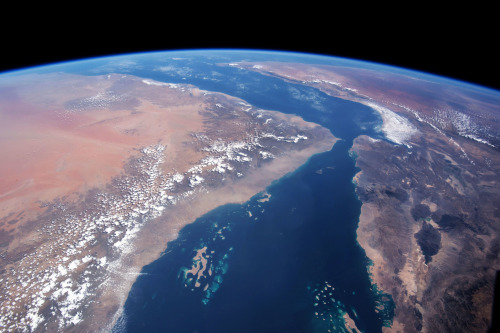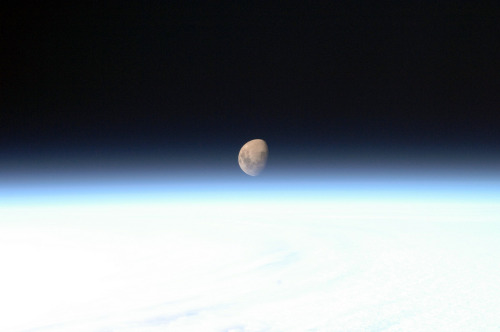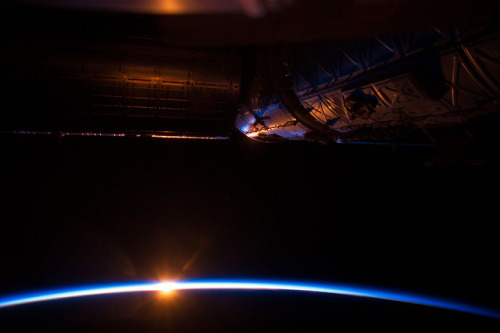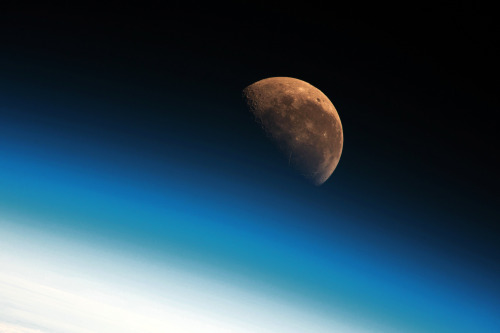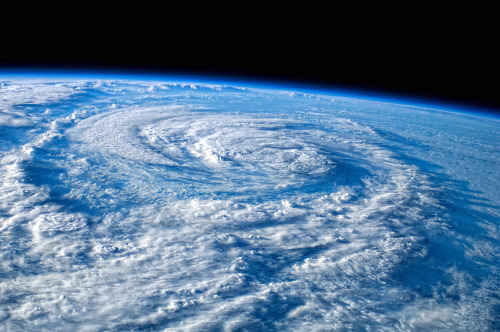The Earth From Russia’s Elektro-L Satellite

The Earth from Russia’s Elektro-L satellite
This image compilation, comprised of images taken by the Russian Elektro-L weather satellite, was taken from a geostationary orbit at a distance of 36,000 km. It shows the changing illumination of Earth as it rotated on the autumnal equinox and illustrate the concept of a geostationary orbit. At this height, the satellite is orbiting at fast as the earth is spinning and stays in the same location relative to the surface of earth.
Credit: Vitaliy Egorov
More Posts from Study-astronomy-biology-ref and Others
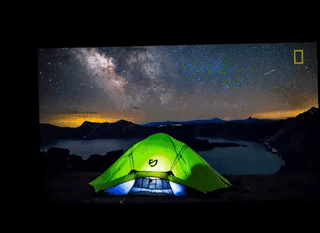
I saw this a long time ago and finally got it to convert to GIF format on tumblr. It shows how it’s the Earth that’s moving, space is standing still. I love this perspective.

Some galaxies have extremely bright cores, suggesting that they contain a supermassive black hole that is pulling in matter at a prodigious rate. Astronomers call these “active galaxies,” and Hercules A is one of them. In visible light, Hercules A looks like a typical elliptical galaxy. In X-ray light, however, Chandra detects a giant cloud of multimillion-degree gas (purple). This gas has been heated by energy generated by the infall of matter into a black hole at the center of Hercules A that is over 1,000 times as massive as the one in the middle of the Milky Way. Radio data (blue) show jets of particles streaming away from the black hole. The jets span a length of almost one million light years.
Credit: X-ray: NASA/CXC/SAO, Optical: NASA/STScI, Radio: NSF/NRAO/VLA
![Some Websites That I Use For Geography [lessons + Revision] - A Mix Of Summary Notes Websites, Statistics,](https://64.media.tumblr.com/72f06e96ed90f93a4ec6344b5f914b80/tumblr_o2dsex58Rq1uk5pc8o2_r1_500.png)
Some websites that I use for geography [lessons + revision] - a mix of summary notes websites, statistics, geo-located data and other goodies :D enjoy! Hope you find something useful!
I’ve only put my faves tbh but ** = I’ve used this a lot A LOT
Scribd: honestly some docs on here are so useful for help structuring your own notes etc. [our teacher uses this one for example for the glossary]
**Sporcle: i use this to test my place knowledge! [i’ve linked you to the world one, but you can find other continent specific ones too]
[Alternative to above that I personally haven’t used much but it looks decent so]
World Mapper: Really cool maps and omg countries look so funny distorted heu heu (HONESTLY SO USEFUL AND VISUAL) [i’ve linked to the old site haha]
**Gapminder: I’ve linked you to the program itself [so so so good omg for global trends over time GENIUS] but Hans Rosling is a cinnamon roll go watch the videos too!!
Information is beautiful: I love infographics okay fight me on this. You could have a look at this one and oh here’s the blog and just have an explore tbh [there’s isn’t a huge number of infographics on here tbh it’s a shame but i guess they’re trying to sell the book so fair]
**Datashine (UK centric): UK Census 2011 info geo-located and ahhh it’s so useful
they also have this one on commuting if you’re about that life
*******CIA World Factbook: ALL THE STATS! LIFESAVER! 10Q America! (that maths pun stop me pls)
Generally amazing website that is succinct and you could probably find so much on here tbh
Quizlet: really useful resource!! flashcards!! i love this site!! (and there’s an app hehe) test yourself on case studies etc!!
[tip: you can duplicate ppl’s flashcards and edit them if there’s anything you want to add!]
BBC bitesize ayyy for gcse peeps! (and in general too :) )
S-cool [linked again to the gcse site cuz that’s what was bookmarked but they have an a-level section too!] Some real concise notes tbh and may be useful even if you aren’t studying gcses/alevels! :)
my other masterpost/ramble hybrids are all (there’s like 2 others lol) here and feel free to come rant at me (or just talk lel) if any links don’t work etc!
in hindsight a better header for this would have been ‘resources i rely on way too much for geography’ (*´◡`)
A Super-Black Coating by Surrey NanoSystems.
This product absorbs 99.7% of light at 600nm wavelength. Unlike the previous product, VantaBlack, this product is much more tolerant and can withstand handling - indicating more realistic worldwide applications.
Crab walks around with Jellyfish on its back to protect it from predators
These #jellyfish Cassiopea (upside-down jellyfish) partake in a symbiotic relationship with photosynthetic dinoflagellates and therefore, must lay upside-down in areas with sufficient light penetration to fuel their energy source. Where found, there may be numerous individuals with varying shades of white, blue, green and brown.
Sometimes this jellyfish is picked up by the #crab Dorippe frascone and carried on its back. The crab uses the jellyfish to defend itself against possible predators.



▪︎Copernican armillary sphere.
Date: 1807-1846
Place of origin: Paris
From the source: Copernican armillary sphere from set of two armillary spheres and a celestial globe constructed in paper on pasteboard with metal fitments supported on a decorative mahogany baluster base. Shows planets out to Uranus, plus four asteroids, Ceres, Pallas, Juno & Vesta, first quarter 19th century.






Could dark energy be caused by frozen neutrinos?
“Since its discovery in 1998, the accelerated expansion has lacked a compelling, simple explanation that didn’t hypothesize a completely new set of forces, properties or interactions. If you wanted a scalar field — a quintessence model — it had to be finely tuned. But in a very clever paper just submitted yesterday by Fergus Simpson, Raul Jimenez, Carlos Pena-Garay, and Licia Verde, they note that if a generic scalar field couples to the neutrinos we have in our Universe, that fine-tuning goes away, and that scalar field will automatically begin behaving as a cosmological constant: as energy inherent to space itself.”
The accelerated expansion of our Universe was one of the biggest surprise discoveries of all-time, and something that still lacks a good physical explanation. While many models of dark energy exist, it remains a completely phenomenological study: everything appears consistent with a cosmological constant, but nothing appears to be a good motivator for why the Universe should have one. Until now, that is! In a new paper by Fergus Simpson, Raul Jimenez, Carlos Pena-Garay and Licia Verde, they note that any generic scalar field that couples to the neutrino sector would dynamically and stably give rise to a type of dark energy that’s indistinguishable from what we’ve observed. The huge advance is that this scenario doesn’t require any fine-tuning, thanks to this dark energy arising from neutrinos “freezing,” or becoming non-relativistic. In addition, there are experimental signatures to look for to confirm it, too, in the form of neutrinoless double-beta decay!
Largest Batch of Earth-size, Habitable Zone Planets
Our Spitzer Space Telescope has revealed the first known system of seven Earth-size planets around a single star. Three of these planets are firmly located in an area called the habitable zone, where liquid water is most likely to exist on a rocky planet.

This exoplanet system is called TRAPPIST-1, named for The Transiting Planets and Planetesimals Small Telescope (TRAPPIST) in Chile. In May 2016, researchers using TRAPPIST announced they had discovered three planets in the system.

Assisted by several ground-based telescopes, Spitzer confirmed the existence of two of these planets and discovered five additional ones, increasing the number of known planets in the system to seven.

This is the FIRST time three terrestrial planets have been found in the habitable zone of a star, and this is the FIRST time we have been able to measure both the masses and the radius for habitable zone Earth-sized planets.
All of these seven planets could have liquid water, key to life as we know it, under the right atmospheric conditions, but the chances are highest with the three in the habitable zone.

At about 40 light-years (235 trillion miles) from Earth, the system of planets is relatively close to us, in the constellation Aquarius. Because they are located outside of our solar system, these planets are scientifically known as exoplanets. To clarify, exoplanets are planets outside our solar system that orbit a sun-like star.

In this animation, you can see the planets orbiting the star, with the green area representing the famous habitable zone, defined as the range of distance to the star for which an Earth-like planet is the most likely to harbor abundant liquid water on its surface. Planets e, f and g fall in the habitable zone of the star.
Using Spitzer data, the team precisely measured the sizes of the seven planets and developed first estimates of the masses of six of them. The mass of the seventh and farthest exoplanet has not yet been estimated.

For comparison…if our sun was the size of a basketball, the TRAPPIST-1 star would be the size of a golf ball.
Based on their densities, all of the TRAPPIST-1 planets are likely to be rocky. Further observations will not only help determine whether they are rich in water, but also possibly reveal whether any could have liquid water on their surfaces.
The sun at the center of this system is classified as an ultra-cool dwarf and is so cool that liquid water could survive on planets orbiting very close to it, closer than is possible on planets in our solar system. All seven of the TRAPPIST-1 planetary orbits are closer to their host star than Mercury is to our sun.

The planets also are very close to each other. How close? Well, if a person was standing on one of the planet’s surface, they could gaze up and potentially see geological features or clouds of neighboring worlds, which would sometimes appear larger than the moon in Earth’s sky.

The planets may also be tidally-locked to their star, which means the same side of the planet is always facing the star, therefore each side is either perpetual day or night. This could mean they have weather patterns totally unlike those on Earth, such as strong wind blowing from the day side to the night side, and extreme temperature changes.

Because most TRAPPIST-1 planets are likely to be rocky, and they are very close to one another, scientists view the Galilean moons of Jupiter – lo, Europa, Callisto, Ganymede – as good comparisons in our solar system. All of these moons are also tidally locked to Jupiter. The TRAPPIST-1 star is only slightly wider than Jupiter, yet much warmer.
How Did the Spitzer Space Telescope Detect this System?
Spitzer, an infrared telescope that trails Earth as it orbits the sun, was well-suited for studying TRAPPIST-1 because the star glows brightest in infrared light, whose wavelengths are longer than the eye can see. Spitzer is uniquely positioned in its orbit to observe enough crossing (aka transits) of the planets in front of the host star to reveal the complex architecture of the system.

Every time a planet passes by, or transits, a star, it blocks out some light. Spitzer measured the dips in light and based on how big the dip, you can determine the size of the planet. The timing of the transits tells you how long it takes for the planet to orbit the star.

The TRAPPIST-1 system provides one of the best opportunities in the next decade to study the atmospheres around Earth-size planets. Spitzer, Hubble and Kepler will help astronomers plan for follow-up studies using our upcoming James Webb Space Telescope, launching in 2018. With much greater sensitivity, Webb will be able to detect the chemical fingerprints of water, methane, oxygen, ozone and other components of a planet’s atmosphere.
At 40 light-years away, humans won’t be visiting this system in person anytime soon…that said…this poster can help us imagine what it would be like:

Make sure to follow us on Tumblr for your regular dose of space: http://nasa.tumblr.com
-
 senpaisimmer liked this · 2 years ago
senpaisimmer liked this · 2 years ago -
 sentiendi reblogged this · 3 years ago
sentiendi reblogged this · 3 years ago -
 savemotherearths-blog liked this · 3 years ago
savemotherearths-blog liked this · 3 years ago -
 summerwages liked this · 3 years ago
summerwages liked this · 3 years ago -
 gmobox liked this · 3 years ago
gmobox liked this · 3 years ago -
 yahveh-nissi reblogged this · 3 years ago
yahveh-nissi reblogged this · 3 years ago -
 yahveh-el-olam liked this · 3 years ago
yahveh-el-olam liked this · 3 years ago -
 theswordfish11 reblogged this · 3 years ago
theswordfish11 reblogged this · 3 years ago -
 theswordfish11 liked this · 3 years ago
theswordfish11 liked this · 3 years ago -
 wapaladin reblogged this · 3 years ago
wapaladin reblogged this · 3 years ago -
 wapaladin liked this · 3 years ago
wapaladin liked this · 3 years ago -
 skyoverhamburg liked this · 3 years ago
skyoverhamburg liked this · 3 years ago -
 emt069 liked this · 3 years ago
emt069 liked this · 3 years ago -
 760717 liked this · 3 years ago
760717 liked this · 3 years ago -
 canadagent liked this · 3 years ago
canadagent liked this · 3 years ago -
 umflowers reblogged this · 3 years ago
umflowers reblogged this · 3 years ago -
 dioptria liked this · 3 years ago
dioptria liked this · 3 years ago -
 daughterofthemoon99 reblogged this · 3 years ago
daughterofthemoon99 reblogged this · 3 years ago -
 daughterofthemoon99 liked this · 3 years ago
daughterofthemoon99 liked this · 3 years ago -
 foxinatree reblogged this · 3 years ago
foxinatree reblogged this · 3 years ago -
 foxinatree liked this · 3 years ago
foxinatree liked this · 3 years ago -
 kerovousphoto liked this · 3 years ago
kerovousphoto liked this · 3 years ago -
 bardofthebored reblogged this · 3 years ago
bardofthebored reblogged this · 3 years ago -
 bardofthebored liked this · 3 years ago
bardofthebored liked this · 3 years ago -
 lifewithchronicpain liked this · 3 years ago
lifewithchronicpain liked this · 3 years ago -
 i-amflawed liked this · 3 years ago
i-amflawed liked this · 3 years ago -
 desertinn liked this · 3 years ago
desertinn liked this · 3 years ago -
 mleighlikes liked this · 3 years ago
mleighlikes liked this · 3 years ago -
 naram--sin liked this · 3 years ago
naram--sin liked this · 3 years ago -
 rivermusic reblogged this · 3 years ago
rivermusic reblogged this · 3 years ago -
 kirtijolapara reblogged this · 4 years ago
kirtijolapara reblogged this · 4 years ago -
 kirtijolapara liked this · 4 years ago
kirtijolapara liked this · 4 years ago -
 rh35211 reblogged this · 6 years ago
rh35211 reblogged this · 6 years ago -
 bored-n-gay reblogged this · 6 years ago
bored-n-gay reblogged this · 6 years ago -
 delphicvoiceaddragh liked this · 6 years ago
delphicvoiceaddragh liked this · 6 years ago -
 gakittajp liked this · 6 years ago
gakittajp liked this · 6 years ago -
 tehyablue-blog liked this · 6 years ago
tehyablue-blog liked this · 6 years ago -
 king-of-the-rain-and-wolves liked this · 6 years ago
king-of-the-rain-and-wolves liked this · 6 years ago -
 cray1110 liked this · 6 years ago
cray1110 liked this · 6 years ago -
 tails-155 liked this · 6 years ago
tails-155 liked this · 6 years ago

This is a studyblr for everyone have some passion for science, especially astronomy and biology
129 posts

